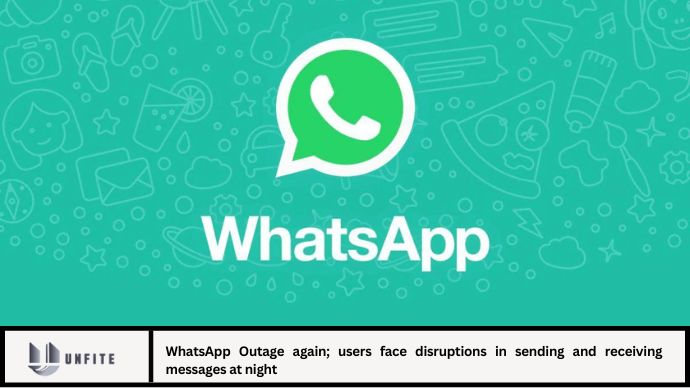WhatsApp Outage again; users face disruptions in sending and receiving messages at night

WhatsApp, a dominant force in the realm of messaging apps, has recently encountered another significant outage, leaving millions of users worldwide grappling with disruptions in sending and receiving messages. This latest service disruption, which occurred primarily at night, has once again highlighted the vulnerabilities in one of the world’s most relied-upon communication platforms.
This article delves into the details of the recent WhatsApp outage, explores its impact on users, examines potential causes, and offers insights into how such disruptions are typically handled. Additionally, we will address common questions and provide a conclusion on the overall situation.
Overview of the WhatsApp Outage
On [insert date], WhatsApp users experienced a widespread outage that severely impacted the app’s functionality. The issues began late in the evening and extended into the night, disrupting communication for users globally. This outage comes as a reminder of the challenges even major tech companies face in maintaining the stability and reliability of their services.
1. Scope of the Outage
The outage affected users across various regions, including North America, Europe, Asia, and parts of Africa. Users reported being unable to send or receive messages, with some experiencing difficulties in accessing media files or using voice and video calling features. The disruption was particularly frustrating given WhatsApp’s role as a primary communication tool for both personal and professional interactions.
2. User Impact
The outage had significant repercussions for users, including:
- Interrupted Communication: Many users were unable to communicate effectively, affecting personal and work-related conversations.
- Missed Messages: Important messages, particularly those related to work or emergency situations, were delayed or missed altogether.
- Inconvenience: The inability to send or receive messages led to frustration and inconvenience, particularly for those in different time zones or with urgent needs.
Potential Causes of the Outage
Understanding the causes behind such outages is crucial for both users and service providers. While specific details about the latest WhatsApp outage may still be emerging, several common factors could contribute to service disruptions:
Server Issues: Technical problems with WhatsApp’s servers can lead to outages. These issues may stem from hardware failures, software bugs, or configuration errors.
Network Problems: Connectivity issues, including problems with internet service providers or data centers, can affect WhatsApp’s ability to deliver messages and maintain connectivity.
Software Bugs: Bugs or glitches in the app’s code may lead to disruptions. Updates or changes to the app can sometimes introduce unforeseen issues that affect functionality.
Security Incidents: Security breaches or attacks can also cause service disruptions. Such incidents may involve DDoS (Distributed Denial of Service) attacks or other malicious activities aimed at overwhelming the service.
Infrastructure Changes: Changes or upgrades to WhatsApp’s infrastructure may occasionally lead to temporary outages. While necessary for improving service, these changes can sometimes cause unexpected issues.
Response and Resolution
WhatsApp’s response to outages typically involves a few key steps:
Identification and Investigation: The first step is to identify the root cause of the issue. This involves monitoring systems, analyzing error logs, and investigating any anomalies reported by users.
Communication: WhatsApp usually communicates with users via social media or its official website, providing updates on the status of the outage and estimated resolution times.
Resolution: Once the cause is identified, WhatsApp’s technical team works to resolve the issue as quickly as possible. This may involve deploying fixes, restoring server functionality, or addressing any underlying problems.
Post-Incident Review: After resolving the outage, WhatsApp conducts a review to understand what went wrong and how similar issues can be prevented in the future.
Comparison with Previous Outages
WhatsApp has experienced several notable outages in the past, each with varying impacts and resolutions. Here’s a brief look at how the recent outage compares to previous incidents:
October 2021 Outage:
- Scope: A global outage affecting WhatsApp, Instagram, and Facebook.
- Cause: An internal configuration error disrupted network traffic.
- Resolution: The issue was resolved within a few hours, and services were restored after fixing the configuration error.
January 2022 Outage:
- Scope: Regional outages affecting specific countries.
- Cause: Server issues related to a regional data center.
- Resolution: Restored service after addressing server-related problems.
April 2023 Outage:
- Scope: Partial outage with intermittent connectivity issues.
- Cause: Network-related problems and maintenance activities.
- Resolution: Service was gradually restored as network issues were resolved.
Best Practices for Users During Outages
While outages can be frustrating, users can take certain steps to mitigate their impact and stay informed:
Check for Official Updates: Follow WhatsApp’s official social media channels or website for updates on the outage and expected resolution times.
Verify Connectivity: Ensure that the issue is not related to your own internet connection by checking other apps and services.
Use Alternative Communication Channels: If urgent communication is needed, consider using alternative methods such as email, SMS, or other messaging apps.
Patience and Flexibility: Understand that resolving technical issues can take time. Exercise patience and be flexible with communication methods during outages.
Report Issues: If you experience ongoing problems or disruptions beyond the reported outage period, consider reporting the issue to WhatsApp’s support team for assistance.
FAQ
What caused the recent WhatsApp outage?
The exact cause of the recent outage is still under investigation. Common causes include server issues, network problems, software bugs, security incidents, or infrastructure changes.
How long did the WhatsApp outage last?
The duration of the outage varied by region, but it primarily affected users during the night. WhatsApp typically provides updates on the resolution time through official channels.
What should I do if WhatsApp is still not working?
If WhatsApp continues to experience issues after the reported resolution time, check your internet connection, update the app, and report the problem to WhatsApp’s support team.
Did the outage affect other services?
The recent outage specifically impacted WhatsApp. However, similar issues have affected other services in the past, as seen in previous incidents involving multiple platforms.
How can I stay informed about WhatsApp outages?
Follow WhatsApp’s official social media accounts, check their website for updates, and monitor tech news sources for information on outages and service status.
Conclusion
The recent WhatsApp outage has once again brought to light the challenges faced by major technology platforms in maintaining uninterrupted service. While the exact cause of the disruption is still being investigated, the impact on users has been significant, affecting communication and causing inconvenience.
As with previous outages, WhatsApp’s response involves identifying the cause, communicating with users, and working towards a resolution. By understanding the potential causes and staying informed, users can better navigate these disruptions and minimize their impact.




